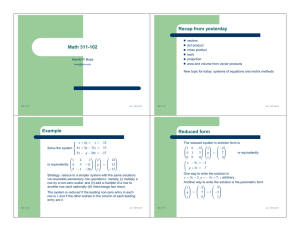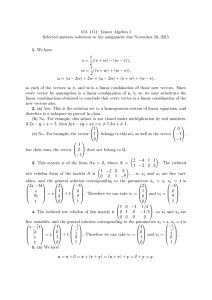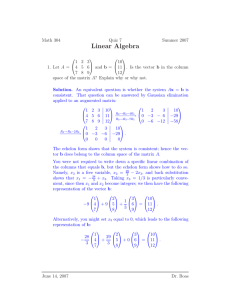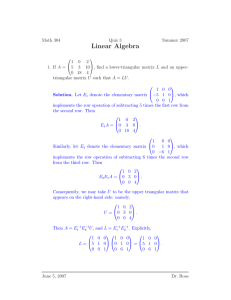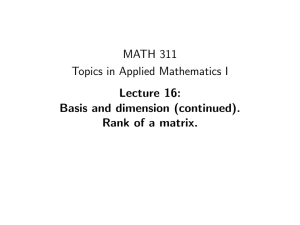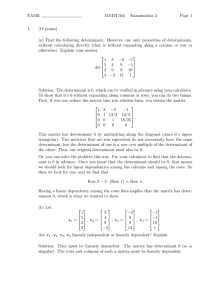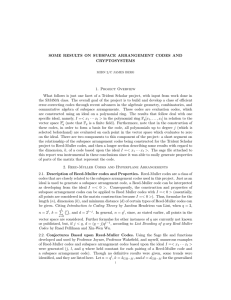Linear Algebra
advertisement
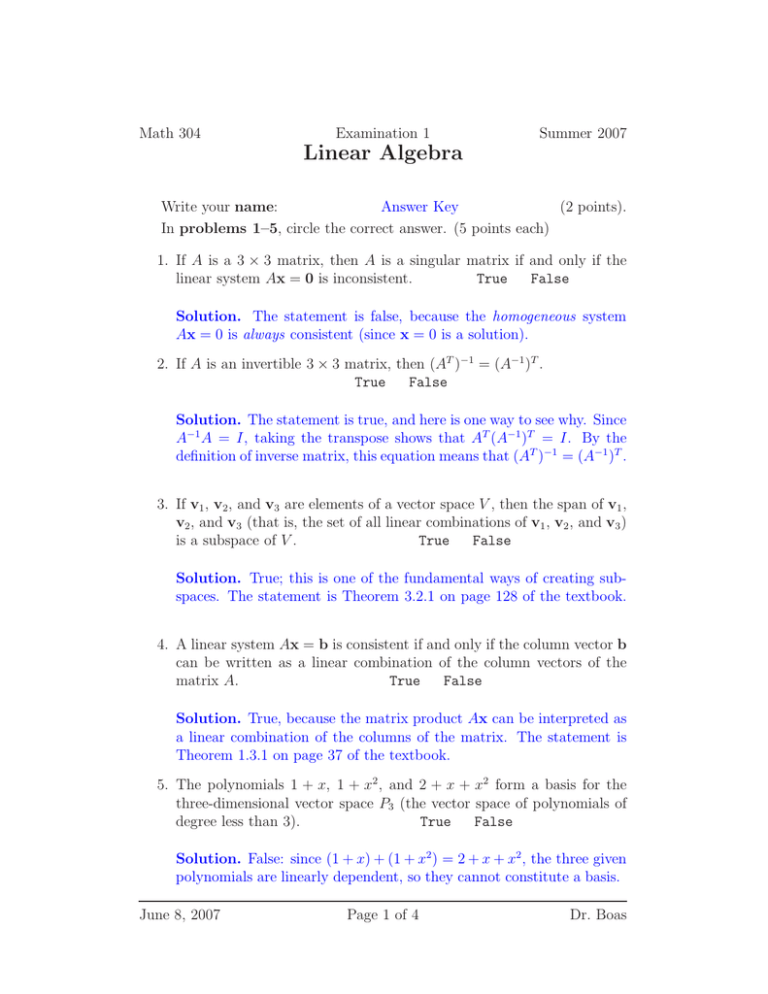
Math 304 Examination 1 Summer 2007 Linear Algebra Answer Key (2 points). Write your name: In problems 1–5, circle the correct answer. (5 points each) 1. If A is a 3 × 3 matrix, then A is a singular matrix if and only if the linear system Ax = 0 is inconsistent. True False Solution. The statement is false, because the homogeneous system Ax = 0 is always consistent (since x = 0 is a solution). 2. If A is an invertible 3 × 3 matrix, then (AT )−1 = (A−1 )T . True False Solution. The statement is true, and here is one way to see why. Since A−1 A = I, taking the transpose shows that AT (A−1 )T = I. By the definition of inverse matrix, this equation means that (AT )−1 = (A−1 )T . 3. If v1 , v2 , and v3 are elements of a vector space V , then the span of v1 , v2 , and v3 (that is, the set of all linear combinations of v1 , v2 , and v3 ) is a subspace of V . True False Solution. True; this is one of the fundamental ways of creating subspaces. The statement is Theorem 3.2.1 on page 128 of the textbook. 4. A linear system Ax = b is consistent if and only if the column vector b can be written as a linear combination of the column vectors of the matrix A. True False Solution. True, because the matrix product Ax can be interpreted as a linear combination of the columns of the matrix. The statement is Theorem 1.3.1 on page 37 of the textbook. 5. The polynomials 1 + x, 1 + x2 , and 2 + x + x2 form a basis for the three-dimensional vector space P3 (the vector space of polynomials of degree less than 3). True False Solution. False: since (1 + x) + (1 + x2 ) = 2 + x + x2 , the three given polynomials are linearly dependent, so they cannot constitute a basis. June 8, 2007 Page 1 of 4 Dr. Boas Math 304 Examination 1 Summer 2007 Linear Algebra In problems 6–9, fill in the blanks. (7 points per problem) ! 1 −1 7 0 and B = , then 2A+B = 6. If A = 5 5 0 4 Solution. If A = 3 0 7 5 1 0 3 1 7. 0 0 −1 . 2 −1 0 1 0 = 0 1 0 3 1 Solution. 0 0 0 and B = 4 1 −1 5 −6 ! 2 ! . , then 2A + B = 0 0 1 0 0 1/4 −1 1 0 0 = −3 0 4 0 0 1 0 0 1/4 8. If A is an n×m matrix, then the set of all solutions to the homogeneous system Ax = 0 is called the of A. Solution. If A is an n × m matrix, then the set of all solutions to the homogeneous system Ax = 0 is called the nullspace of A. 1 2 0 5 4 9. If is the end stage of the Gauss-Jordan reduction 0 0 1 30 algorithm applied to the augmented matrix of a system of linear equations, then the system of equations has solution(s). [none, exactly one, or infinitely many?] Solution. The system is consistent and has two free variables, so there are infinitely many solutions. June 8, 2007 Page 2 of 4 Dr. Boas Math 304 Examination 1 Summer 2007 Linear Algebra In problems 10–12, show your work and explain your method. Continue on the back if you need more space. (15 points each) 1 3 0 10. If A = 6 19 4 , find a lower triangular matrix L and an upper 0 8 33 triangular matrix U such that A = LU. 1 0 0 Solution. Let E1 be the elementary matrix −6 1 0. Then 0 0 1 1 3 0 1 0 0 1 0. E1 A = 0 1 4 . Let E2 be the elementary matrix 0 0 8 33 0 −8 1 1 3 0 Then E2 E1 A = 0 1 4 := U. We have A = LU if 0 0 1 1 0 0 1 0 0 1 0 0 L = E1−1 E2−1 = 6 1 0 0 1 0 = 6 1 0 . 0 0 1 0 8 1 0 8 1 11. Determine the value of a for which 3 0 4 0 3 0 det 1 0 1 0 1 0 0 4 = 0. 0 a Solution. One can either compute the determinant using a cofactor expansion or simplify the determinant using row operations. Here is a solution via the second method. Making two row interchanges (hence two cancelling sign changes) gives 1 0 1 0 0 1 0 a 3 0 4 0 . 0 3 0 4 June 8, 2007 Page 3 of 4 Dr. Boas Math 304 Examination 1 Summer 2007 Linear Algebra Now subtracting 3 times the first row from the third row and 3 times the second row from the fourth row gives 1 0 1 0 0 1 0 a . 0 0 1 0 0 0 0 4 − 3a The determinant of this triangular matrix is the product of the entries on the main diagonal, 4 − 3a. Therefore the determinant is equal to 0 when a = 4/3. 12. Let v1 be the vector in R3 whose entries are the first three digits of your student identification number. Similarly, let v2 be the vector whose entries are the middle three digits of your identification number, and let v3 be the vector whose entries are the last three digits of your identification number. Are your vectors v1 , v2 , and v3 linearly independent vectors in R3 ? Explain why or why not. Solution. One method is to write the three vectors as the columns of a matrix and to compute the determinant. If the determinant is equal to 0, then the vectors are linearly dependent; otherwise the vectors are linearly independent (Theorem 3.3.1 on page 139 of the textbook). Alternatively, you could reduce the matrix to echelon form. If the echelon form has a row of zeroes at the bottom, then the original vectors are linearly dependent; otherwise the vectors are linearly independent. June 8, 2007 Page 4 of 4 Dr. Boas

